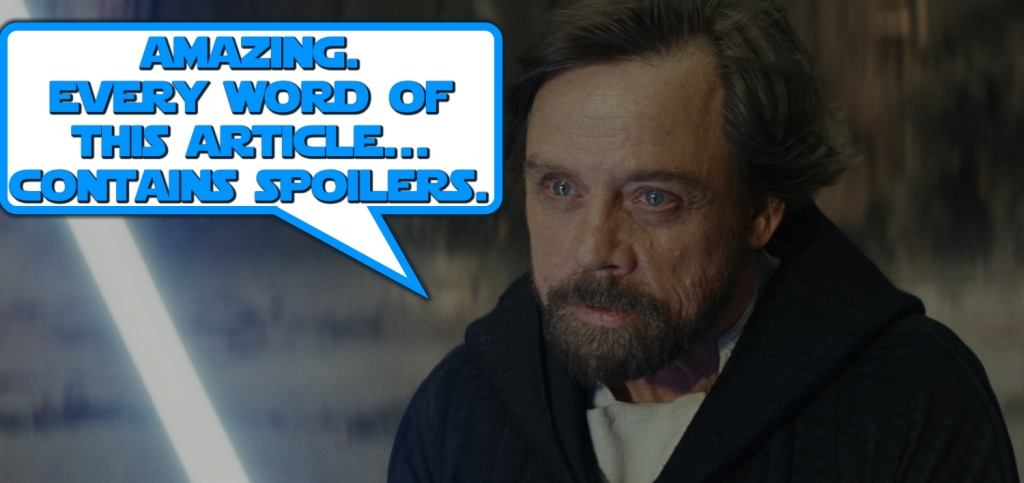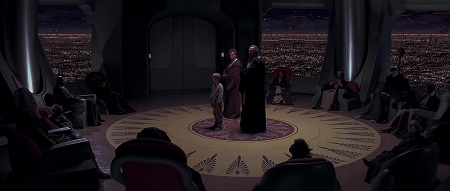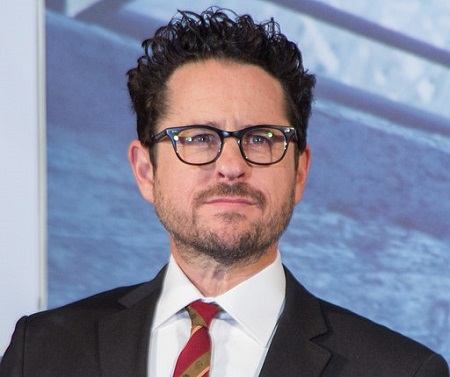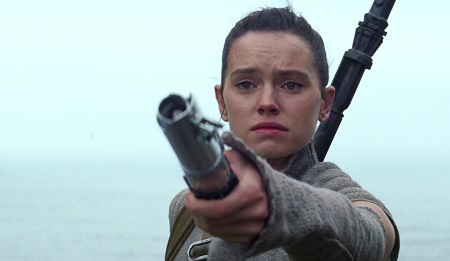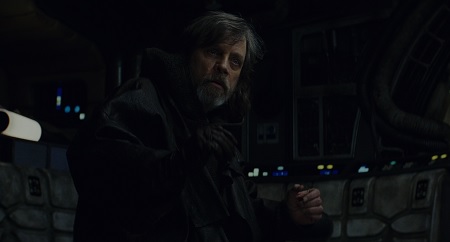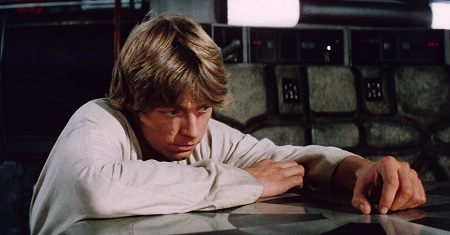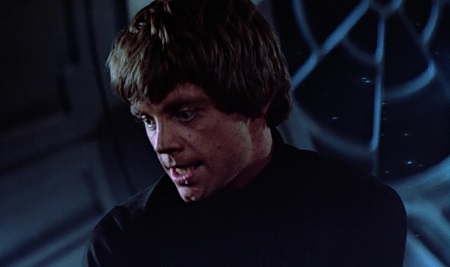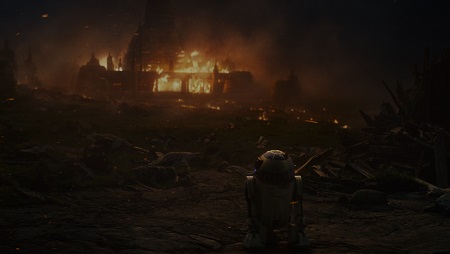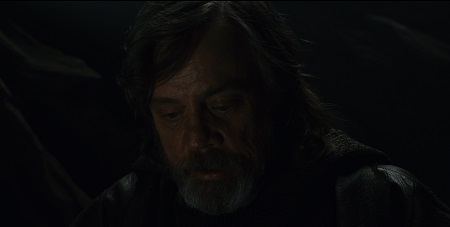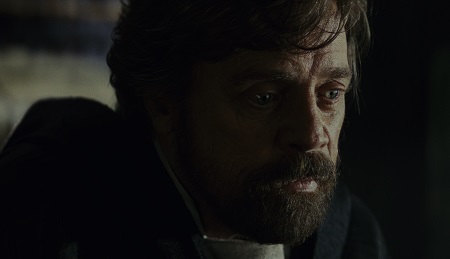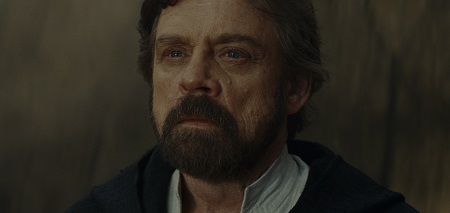
Spoiler Warning: There are spoilers ahead for the entire Star Wars franchise, including the prequels, original trilogy, and sequels.
Happy Star Wars Day! Today is the 4th of May – or as they say in America, May the 4th. So May the 4th be with you! Today is a day for positivity in the Star Wars fan community, so I thought it could be fun to take a look at a few of my favourite things from The Last Jedi. It goes without saying that The Last Jedi was a divisive film among Star Wars fans. However, it was one I generally enjoyed. It wasn’t “perfect,” and I don’t think it hit all of the high notes that it was aiming for, but I found it to be enjoyable.
This article isn’t an attack on anyone else’s position or opinion! If you don’t like The Last Jedi or some of the things we’re going to discuss, that’s totally okay. Practically everything in cinema is subjective, not objective, and there’s a range of opinions on practically every film. Because today is about celebrating Star Wars, I wanted to pick out some of the things that I liked from the film and talk about why they worked well for me. If you want to see how critical I can be of Star Wars… check out my reviews of The Rise of Skywalker or The Mandalorian Season 2!

With all of that out of the way, a brief introduction is in order, I think! Star Wars Episode VIII: The Last Jedi was released theatrically in the UK on the 14th of December 2017 – but I didn’t see it until a few months later in the Spring of 2018. My health is poor, and things like trips to the cinema are no longer practical for me, unfortunately. By the time I got around to seeing the film I’d already heard the outcry from some in the Star Wars fandom, and I set my expectations pretty low for what seemed to be a divisive film. Suffice to say that I was pleasantly surprised to find a film that I enjoyed a lot more than I’d been expecting.
After The Force Awakens had played it very safe two years earlier, The Last Jedi attempted to take Star Wars in a very different direction. Rather than repeating what the original trilogy had done, the film took its characters to completely different thematic places, introduced new sub-plots, and potentially set up the sequel trilogy for a radically different ending. The Rise of Skywalker tried to undo some of the most significant points from The Last Jedi, which was a real shame, but taken on their own merit many of these points succeed. For me, The Last Jedi is the high-water mark of the sequel trilogy, and it’s a film that I firmly believe will be considered much more favourably in years to come. Just look at how a new generation of fans has come to celebrate the once-panned prequel trilogy; The Last Jedi’s best days may lie ahead.
So let’s get started on my list! I’ve picked ten things that I admire about The Last Jedi or feel that the film did well. They’re listed below in no particular order.
Number 1:
A subtle and unexpected Rogue One connection.

How was the First Order able to track the Resistance’s fleet while they were in hyperspace? This was a story point that some fans who weren’t paying very close attention didn’t like – but it was actually something that had been set up a year earlier. Rogue One, which was released in 2016, saw Jyn Erso and a rag-tag crew steal the plans to the Death Star in the days immediately prior to A New Hope. Part of their mission saw them travel to the planet of Scarif, where the plans were kept at an Imperial facility.
While looking for the Death Star plans in amongst other Imperial data tapes, Jyn found a record of the Empire’s research into hyperspace tracking. The scene was very brief, with the data tape quickly being discarded in the rush to secure the Death Star plans – but it was a great moment of connection between two disparate parts of the Star Wars franchise!

Considering that Rogue One and The Last Jedi were set decades apart, these moments of connection are incredibly helpful to bind modern Star Wars together. Far from being just a throwaway line, the scene in Rogue One established that hyperspace tracking technology was something being actively researched by the Empire – while the destruction of the Imperial facility on Scarif provides a convenient narrative excuse for why it wasn’t successfully rolled out during the era of the original films.
It can be an incredibly difficult task to thread the needle like this; to insert a story element in between the pieces of the story that we already know. But Rogue One and The Last Jedi did this perfectly. If only other story beats in the sequel trilogy had this much forethought and this much setup!
Number 2:
Rey is related to nobody.

For two years leading up to The Last Jedi, speculation was rife in the Star Wars fan community about who Rey was. Many fans concocted elaborate theories suggesting that she was the daughter or granddaughter of Luke Skywalker, Obi-Wan Kenobi, Emperor Palpatine, and other Force-wielding characters. But when it was revealed in The Last Jedi that none of those things were true, it was a perfectly-executed twist.
Rey being “no one” isn’t just great because it’s a subversion or because it ignores some pretty mediocre fan theories – it works because it has something important to say. The Force can manifest in anyone, and just because that person comes from a humble background it doesn’t mean that they can’t be important. This is the story that the original Star Wars film tried to tell: Luke was the farm boy from an unimportant backwater world who went on to save the galaxy. That story was muddied by the decision to create a connection to Darth Vader in The Empire Strikes Back, and completely erased by the time talk of prophecy and “chosen ones” entered the equation.

In that sense, Rey’s parents being no one important and no one familiar took Star Wars back to a narrative space that it hadn’t occupied since 1977. It established that its hero truly could be anybody, that destiny and ancestry don’t matter half as much as we might’ve thought. I found that message to be incredibly uplifting and inspiring, and the idea that anyone could be a hero or do great things without needing to be related to someone important is a message that resonated. In a franchise that has been so thoroughly dominated by a handful of individuals and a single family, it was a narrative worth including.
It also presented Rey in stark contrast to Kylo Ren. Both characters were defined by their family, but in different ways. Rey waited for her parents believing they’d come back for her, only to learn that they didn’t care about her at all – they sold her at the first opportunity. Kylo was both proud of his relationship to Darth Vader and ashamed of the role that his parents played in the Rebellion. Kylo came from Rebel royalty as the son of Han and Leia, but had succumbed to the temptation of the Dark Side and wanted to dominate the galaxy. In contrast, Rey came from nowhere and wanted to save it.

Rey’s struggle wasn’t to live up to some legacy from Luke or Obi-Wan, nor to rebel against a darker ancestor like Palpatine, but to chart her own path – a new path for herself, for the Resistance, for the Jedi, and for the Star Wars franchise. Rey represented the new against the old, the people against the aristocratic elite, and an unexpected journey for the protagonist of the latest chapter of the long-running saga.
I adored this about Rey. It took her on an unpredictable and open-ended journey, threw out of the window outdated notions of legacy and destiny, but at the same time it returned Star Wars to a familiar place; a place it hadn’t been since Darth Vader and Luke were retconned to be father and son. Had this aspect of Rey’s character been retained, I think the sequel trilogy as a whole could’ve been far more interesting.
Number 3:
Hyperspace ramming.

In the very first Star Wars film, Han Solo gave us a decent explanation for why travelling through hyperspace was so dangerous. “Without precise calculations,” he told Luke, “we could fly right through a star or bounce too close to a supernova.” Hyperspace, at least according to Han Solo, did not somehow transport ships to another dimension; they could still interact with the rest of the galaxy – with potentially deadly consequences!
This was elaborated on by the old Expanded Universe which explained that charting new hyperspace routes was incredibly dangerous for precisely the same reason: it’s very easy to crash into a star, a planet, or even another starship. So hyperspace ramming has always been possible in Star Wars – even if no one thought of it before Admiral Holdo!

Hyperspace ramming is the kind of desperate, last-ditch manoeuvre that no one would dare to try unless there weren’t any other options. Here in the real world, aircraft had been around for decades before anyone thought of inventing the kamikaze suicide attack, so I can absolutely believe that hyperspace ramming was either totally new in the Star Wars universe or hadn’t been attempted in hundreds or thousands of years. Nothing about it “broke” continuity, and as stated it was perfectly in line with what Han Solo had told us about travelling through hyperspace all the way back at the beginning of the franchise!
The criticisms of hyperspace ramming felt very nitpicky to me, and I think it’s something that came about because of how other aspects of the film landed for some fans. If hyperspace ramming had made its debut in The Mandalorian, for example, where most fans seem to have been having a good time, I think it would’ve generated a lot less anger!

I’m always a sucker for the “doomed last stand” concept in fiction, and the entire hyperspace ramming sequence was executed incredibly well. Admiral Holdo managed to be stoic and brave in the face of death, making the ultimate sacrifice to allow her friends to escape and to give the Resistance a fighting chance.
The cinematography and visual effects used to bring it to life were outstanding, too, and the hyperspace ramming sequence has to be one of the absolute best in all of Star Wars for me. The use of silence at the moment of impact was so incredibly poignant – in part because silence is used so sparingly across the franchise. The CGI animation used to bring to life the crash and its aftermath was likewise fantastic.
Number 4:
Kylo Ren seizes power.

The Force Awakens seemed to be setting up Kylo Ren as the “new Darth Vader” – an evil but ultimately redeemable villain. The Last Jedi chose to avoid recycling that character trope and set Kylo on his own path, a path that would lead him to become the Supreme Leader of the First Order. By embracing the darkness within him and extinguishing the pull to the light that he’d been feeling, Kylo Ren cemented his position as the primary antagonist of the sequel trilogy.
After being bullied and belittled by Supreme Leader Snoke, Kylo’s hatred for his master had been building. Blamed unfairly for the loss of Starkiller Base and Rey’s escape, Kylo nursed a grudge against Snoke for practically the whole film, culminating in him killing him in one of the film’s most shocking sequences.

Kylo killing Snoke was not an empty subversion, designed for shock value and nothing else. It was a masterstroke of writing, one that sought to take Star Wars and the film’s main characters to entirely different thematic places than either the prequels or original trilogy had. In the span of a few minutes it seemed that Rey had been able to get through to Kylo, convincing him to betray the First Order… but then that idea was pulled away as Kylo saw his chance to seize power.
Turning the idea of “reaching out” on its head, it was Kylo who asked Rey to join him, to rule the galaxy at his side. Rather than returning to the light, Kylo had taken a massive leap further into the dark – going so far, surely, as to never be able to come back. With Snoke out of the picture, only Kylo and Hux would remain as major antagonists going into the final act of the trilogy, so it seemed like the idea of “Darth Vader 2.0” was well and truly gone.

Again, this was a moment with a message. Part of that message was epitomised by Luke’s line: “this is not going to go the way you think!” and that’s kind of built into the film’s entire philosophy. But beyond that, the concept that someone like Kylo Ren could be irredeemable has merit. There are some people – some fascist leaders, which is what Kylo Ren is at this point – who go “full Dark Side.” There’s no way back for some people, and we shouldn’t want to see a redemption arc for people who have done unspeakably evil things.
It’s also connected to the point above about destiny and ancestry. Kylo came from Rebel royalty as the son of Han Solo and Leia, but instead of using that legacy and power in a positive way he became corrupted, trying to rule the galaxy instead of fighting for freedom. The lure of power can corrupt even the most well-meaning of individuals, and Kylo’s arrogance, elitism, and belief in his own special place led him down a dark path.
Number 5:
The presentation of Luke Skywalker.
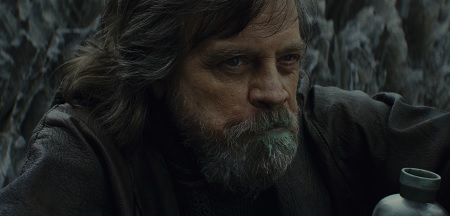
This is a point I’ve tackled before in a standalone essay, but I found what The Last Jedi did with Luke to be absolutely incredible. It was a powerful and relatable mental health story, one that showed how anyone – even heroes – can fall into melancholy and depression. Maybe that story isn’t what some viewers wanted, but I firmly believe it’s a story that was needed – and worth telling.
Not only that, but Luke’s story was a sympathetic and realistic portrayal of mental health; one of the better depictions of depression that I’ve seen in fiction in recent years. Having tried to rebuild the Jedi Order, Luke ultimately failed – and failed in such a catastrophic way that he got people killed. He allowed that failure to fester and turn into depression, ultimately secluding himself and merely waiting around to die, totally uninterested in the galaxy around him.
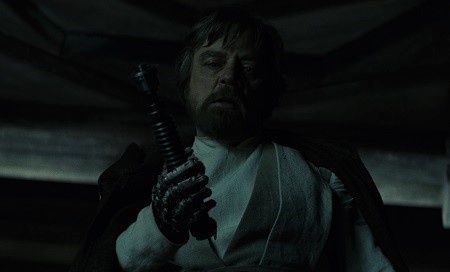
Anyone who’s suffered from depression – regardless of whether there was a cause – can relate to that. The idea of cutting oneself off from everything and everyone, of being unable to face the world outside a small bubble of safety – these are things that people suffering from mental health issues can recognise. And the fact that it happened to someone as powerful, virtuous, and heroic as Luke Skywalker has an incredibly powerful point to make: this is something that can happen to anyone.
As mental health issues – particularly in men – continue to be ignored and stigmatised, this is something that people need to see and hear. The depiction of one of the main protagonists in one of the biggest cinematic franchises around suffering from depression in a realistic and relatable way has done so much to raise awareness of the problem. To me, this is sci-fi at its best: using a fantasy setting to consider real-world issues.

As always in these kinds of stories, how Luke was feeling at the beginning is not as important as where he ended up, and the arc he goes through in The Last Jedi provides a genuine feeling of hope. Thanks to Rey’s intervention, Luke found a way to believe in a cause again, and found a way to become a symbol of hope for the entire galaxy. Luke being depressed at the beginning was incredibly important for people to see, but what was just as important is how he found a pathway out of it.
Depression isn’t something easily cured. Luke couldn’t just “snap out of it,” but he came to realise that, despite his failings, despite his flaws, and despite the way he’d been feeling, there was still something he could do to contribute. He could still be a Jedi – and thanks to his intervention, not the titular Last Jedi!
Number 6:
Recognising the massive failings of the old Jedi Order.

The prequel trilogy touched on the idea that the Jedi Order had grown arrogant and complacent over centuries of peace and after being unchallenged by the Sith and the Dark Side in a major way. But at the same time, characters like Obi-Wan Kenobi, Yoda, Qui-Gon Jinn, and Mace Windu were presented as the heroes – the paragons of virtue who we were rooting for. The Last Jedi takes a much more critical lens to its examination of the Jedi Order, particularly in the prequel era.
Luke explained to Rey that the hubris of the Jedi is what allowed Palpatine to rise to power in the first place, and that the Jedi Order failed not only at keeping the peace but at preserving the Republic itself. Though this wasn’t something that the film spent a huge amount of time on, I think it was an important acknowledgement to recognise that the Jedi Order – by the time of the prequel films, at least – was not the irreproachable organisation that some considered it to be.

This is also something that could inform Star Wars’ future. We don’t know what will become of the Jedi in the aftermath of the sequel trilogy, but it seems to me that one of the lessons Rey learned from Luke is that simply trying to reconstruct the Jedi Order exactly as it was before the Empire is not only impossible, but undesirable as well. What comes next for the Light Side of the Force has to be different – it has to be better.
This potentially opens up the future of Star Wars to go in some very different storytelling directions. Rather than simply a return to the pre-Empire status quo, in which the era of the Galactic Civil War may end up looking like little more than a blip in the grand scale of galactic history, what happened to Luke and Rey could be a turning point for the Light Side of the Force, with a new organisation bound by different rules rising in the Jedi’s stead. Perhaps the name “Jedi” will survive (it’s an integral part of Star Wars, after all), but maybe what comes next will be significantly different from the prequel-era Jedi Order, setting the stage for some genuinely different and unpredictable stories in the years ahead.
Number 7:
Timely social commentary.

How often have we felt that, no matter what we do, the rich always manage to get richer while we stay poor? The Last Jedi took Finn and Rose to one of the meeting places of the galactic elite, showing us how the mega-rich of the galaxy gamble and play both sides in the conflict. To them, who wins the war isn’t important – because they know that either way, they’re going to come out on top.
This isn’t just about the arms dealers who were selling weapons to both sides – although that was a very in-your-face analogy – but really the entire gaggle of the super-rich that Finn and Rose encountered on Canto Bight. Just like the 1% here in the real world, the problems of the galaxy don’t affect them at all. It was, in a sense, a glimpse behind a curtain that we rarely get to see – and the fact that the people of Canto Bight were laughing, joking, gambling, and greedily stuffing their faces seemed to spit in the face of our heroes and their war effort.

This was a side of the Star Wars galaxy that we’d never really seen. We’d been introduced to bounty hunters in shady cantinas before, as well as seeing the corrupt decadence of Coruscant’s politicians in the prequels, but it makes sense that a society as complex as the Star Wars galaxy would have these kinds of places inhabited by these kinds of people. They’re the Wall Street gamblers, the bankers, the financiers who survived the Republic, the Empire, the New Republic, and the First Order all by owning and controlling the vast majority of the galaxy’s money.
One of the themes that I took from this side-story is that, in a sense, it doesn’t matter who wins or loses in the struggle for power. Either a new Republic or the First Order will eventually have to cut deals with these people; they’re the real powerbrokers in the galaxy. Their money can shift the tide of the war – it can literally see states rise or fall.

Perhaps Canto Bight hit too close to home for some folks, or perhaps this look behind the curtain was a little too bleak! But there was something powerful about it nonetheless, particularly in the aftermath of some turbulent political times here in the western world. As above, when sci-fi turns a spotlight on real-world issues, what results can be powerful storytelling if it’s done right.
From an in-universe point of view, Star Wars stories have generally focused on underdogs – scrappy groups of rebels fighting against the powers that be. Even the prequels didn’t explore much of this side of the galaxy – so it was something new, something interesting, and something that could be ripe for further exploration one day.
Number 8:
Porgs!

The Last Jedi introduced us to porgs – beakless bird-like critters that inhabited Luke’s island on the isolated Jedi planet of Ahch-To. Porgs are adorable and they made an excellent addition to the Star Wars galaxy. Was their pretty sizeable appearance in the film purely a merchandising ploy that did nothing whatsoever to service the plot? Well, probably. But Star Wars has always been about the merch!
I had the porg variant of the film’s poster on display for a long time and I also bought a porg plushie, so I guess I’m a sucker for cute merchandise. Paul the porg is now a permanent fixture in my living room, and I have The Last Jedi to thank for that!
Number 9:
General Leia’s leadership.

The film’s release was bittersweet due to the death of Carrie Fisher a year earlier, making her posthumous role in The Last Jedi all the more poignant. Having had limited screen time in The Force Awakens, which focused more on Han Solo, The Last Jedi became a strong film for Leia’s character, showing her leadership skills and expanding on her role in the aftermath of the events of the original films.
There was a clash between the “hot-headed” Poe Dameron and the cooler, calmer Leia and Holdo at the head of the Resistance. Unfortunately Leia was sidelined for part of that, but her return just in time to stop Poe from sabotaging a carefully-laid out plan was one of the film’s strongest moments – and one that showed Leia’s no-nonsense attitude!

Leia also got a sweet moment with Luke shortly before his last stand against the First Order’s forces, and considering that the sequel trilogy didn’t have many moments where it put the original characters back together, this was all the more significant. Fans needed to see Luke and Leia back together one final time – it was certainly one of the things I wanted from the sequels.
Even in the original trilogy, Leia was no “damsel in distress.” She helped Luke and Han escape from the Death Star, saved Luke’s life on Cloud City, killed Jabba the Hutt, and led the mission to take down the second Death Star’s shield! Seeing her continuing the fight against evil – even when it meant standing against her own son – was incredibly powerful.
Number 10:
Taking Star Wars to new thematic places.

I talked about this above when discussing Kylo and Rey in particular, but The Last Jedi did more than any film in the franchise before or since to try to take Star Wars to different thematic and narrative places. That’s incredibly important, because without changing with the times and adapting, Star Wars as a whole will remain stuck in place.
Star Wars hasn’t yet been able to successfully move on from the one story that has been told. Palpatine, Anakin, Luke, Leia, Kylo, Rey, and the other main characters have come to utterly dominate Star Wars in every cinematic and television adaptation so far, even appearing in the likes of The Mandalorian and The Book of Boba Fett. The Last Jedi, as a sequel, obviously had to include many of those same characters, but the way it framed them was as close as Star Wars has got so far to going to different places.

If the franchise is to survive long-term, it will have to find a way to leave Luke, Leia, Anakin, and the others behind; to branch out into different eras with wholly different casts of characters to whom names like “Skywalker” or “Palpatine” mean nothing. There’s a limit to how many different ways the same few characters can save the galaxy over the span of a few short years, and by making massive decisions such as killing off Luke Skywalker, The Last Jedi tried to guide the franchise to a new destination.
The board at the Walt Disney Company is now pushing back hard against that, and we’ve seen the results not only in The Rise of Skywalker, but also through decisions to include characters like Luke Skywalker in The Mandalorian or to bring back Obi-Wan Kenobi for his own miniseries. Partly that’s corporate cowardice – Disney wants to retreat to what it sees as safe, comfortable ground. But that ground is getting overtrodden, and there’s a danger that Star Wars could get bogged down. The Last Jedi, for whatever faults you may think it has, tried to do something genuinely different – and trying new things is how a franchise grows and comes to learn what works.

As the dust settles and the film’s divisiveness abates, I think we’ll start to see a reevaluation of this aspect of The Last Jedi in particular. It may not have succeeded at taking the sequel trilogy to a very different end point, but it stands as a piece of the franchise’s cinematic canon that wasn’t afraid to try different things with its characters and storylines. Perhaps, in time, fans will come to appreciate that – particularly if Star Wars continues to double-down on recycling characters and shining spotlights on increasingly irrelevant chapters of its only real story.
Killing off its main villain early in the story, setting his apprentice on a dark path instead of the path to redemption, tearing down the arrogance of the old Jedi Order, reflecting real-world issues like mental health and the gilded indifference of the super-rich… these are all things that Star Wars had never even considered. The Last Jedi tried them for the first time. Did it all work perfectly? Probably not. But in a franchise that is in serious danger of becoming stale and fixated on its own past, trying new things, exploring new themes, dealing with new character types, and making an effort to stay grounded and relatable are all deserving of praise in my view.
So that’s it!

Those are ten things that I think are pretty great about The Last Jedi. Despite the controversy the film generated, there are signs that the Star Wars fan community is coming back together. Shows like The Mandalorian have gone a long way to bringing back into the fold fans who’d been ready to give up on modern Star Wars. And just like the prequels – which are being revisited by a new generation of fans who were kids when they were released – in a few years’ time I think we’ll see a similar reappraisal of The Last Jedi by newer and younger fans who first came to Star Wars during the sequel era.
Although The Rise of Skywalker did what it could to overwrite or ignore some of what I consider to be The Last Jedi’s highlights, I still find it an enjoyable experience to go back and re-watch it. In a way, it’s a time capsule of where the franchise was in 2017 – or a window into an alternate timeline where Star Wars continued on this trajectory instead of panicking and trying to course-correct.
As we celebrate Star Wars day, don’t forget The Last Jedi.
Star Wars: Episode VIII – The Last Jedi is available to stream now on Disney+ and is also available on DVD and Blu-ray. The Star Wars franchise – including The Last Jedi and all other properties mentioned above – is the copyright of The Walt Disney Company and Lucasfilm. This article contains the thoughts and opinions of one person only and is not intended to cause any offence.



